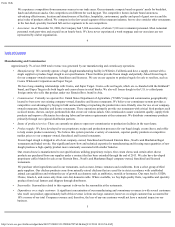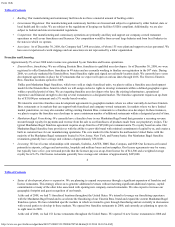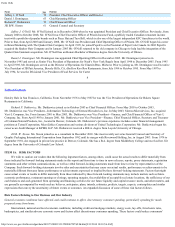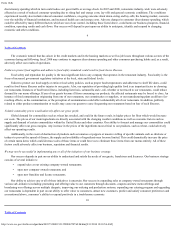Einstein Bros 2008 Annual Report Download - page 14
Download and view the complete annual report
Please find page 14 of the 2008 Einstein Bros annual report below. You can navigate through the pages in the report by either clicking on the pages listed below, or by using the keyword search tool below to find specific information within the annual report.
Form 10-K
http://www.sec.gov/Archives/edgar/data/949373/000119312509042707/d10k.htm[9/11/2014 10:10:56 AM]
methodology for determining ownership changes in accordance with Internal Revenue Code Section 382 on December 30, 2008. In the event that
our request is not accepted, approximately $40.5 million of NOL carryforwards will be at risk to expire prior to utilization. Similar rules and
limitations may apply for state income tax purposes as well.
Risk Factors Relating to Our Common Stock
We have a majority stockholder.
Greenlight Capital, L.L.C. and its affiliates (“Greenlight”) beneficially own approximately 67% of our common stock as of December 30,
2008. As a result, Greenlight has sufficient voting power, without the vote of any other stockholders, to determine what matters will be submitted
for approval by our stockholders to elect all of the members of our board of directors, and to determine whether a change in control of our company
occurs. Greenlight’ s interests on matters submitted to stockholders may be different from those of other stockholders. Greenlight has voted its
shares to elect our current board of directors, and the chairman of our board of directors is a current employee of Greenlight.
We have listed our common stock on the NASDAQ Global Market. NASDAQ rules require us to have an audit committee consisting entirely
of independent directors. However, under NASDAQ rules, if a single stockholder holds more than 50% of the voting power of a listed company,
that company is considered a controlled company, and is exempt from several other corporate governance rules, including the requirement that
companies have a majority of independent directors and independent director involvement in the selection of director nominees and in the
determination of executive compensation. As a result, our stockholders do not have, and may never have, the protections that these rules are
intended to provide. The Company currently has a majority of independent directors on the board of directors.
Future sales of shares of our common stock by our stockholders could cause our stock price to fall.
If a substantial number of shares of our common stock are sold in the public market, the market price of our common stock could fall. The
perception among investors that these sales will occur could also produce this effect. Our majority stockholder, Greenlight, beneficially owns
approximately 67% of our common stock as of December 30, 2008 and sales by Greenlight or a perception that Greenlight will sell could cause a
decrease in the market price of our common stock.
16
Table of Contents
ITEM 1B. UNRESOLVED STAFF COMMENTS
None
ITEM 2. PROPERTIES
Our Properties
All of our restaurants are located on leased premises. As of December 30, 2008, leases for approximately 26 restaurants are set to expire
within the next 12 months and most of these leases contain a renewal option, usually with modified pricing terms to reflect current market rents.
Lease terms are usually five to 10 years, with either two, three or five year renewal option periods, for total lease terms that average approximately
11 to 20 years. Our leases generally require us to pay a proportionate share of real estate taxes, insurance, common charges and other operating
costs.
As of December 30, 2008, we have identified approximately 10 to 15 company-owned restaurants that we anticipate closing over the next
three years as their leases expire. Generally, these restaurants have an average unit volume of less than $650,000 and contribute negative or
negligible cash flow. Additionally, there are four restaurants with average unit volumes greater than $650,000 that we anticipate closing over the
next three years as they are either in areas being taken over by eminent domain or the landlord is completely redeveloping the area and will not
renew our lease.
The average Einstein Bros. restaurant is approximately 2,200 to 2,500 square feet in size with approximately 40 seats and is generally
located in a neighborhood or regional shopping center. We design each restaurant to create a comfortable, casual environment that is consumer
friendly, inviting and reflective of the brand’ s personality and strong neighborhood identity.
The average Noah’ s restaurant is approximately 1,800 to 2,400 square feet in size with approximately 30 to 40 seats and is located in urban
neighborhoods or regional shopping centers. We use elaborate tile work and wood accents in the brand’ s design to create an environment
reminiscent of a Lower East Side New York deli, which reinforces the brand’ s urban focus with an emphasis on the authenticity of a New York deli
experience.
The average Manhattan Bagel restaurant is approximately 1,400 to 2,500 square feet with 24 to 50 seats and is primarily located in suburban
neighborhoods or regional shopping centers. Manhattan Bagel restaurants are designed to combine the authentic atmosphere of a bagel bakery with
























